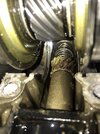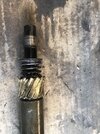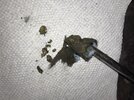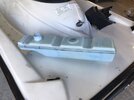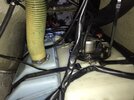Some things to consider:
"In gear applications, bronze parts act as sacrificial components. Generally you are dealing with a bronze-to-steel mating application, where the bronze component is sacrificed to protect the more valuable steel component. In these cases, the steel surfaces must always be harder than the bronze surfaces."
"Brass is a soft metal that may be used in cases when a low chance of sparking is necessary."
The Brass Gear is a sacrificial wear item by design. Cheaper to replace the Rotary Valve Shaft then Crank Shaft.
"Scuffing, also termed "scoring" (incorrect according to gear standards), is a severe type of adhesive wear which instantly damages tooth surfaces that are in relative motion. In fact, a single overload can lead to catastrophic failure.
Scuffing welds together unprotected surfaces in metal-to-metal contact. Metal particles detach and transfer from one or both meshing teeth. During successive rotations, these particles can scratch teeth flanks in the sliding direction. This type of damage generally happens in areas of high contact pressure and sliding velocity, far from the pitch surface. Conditions there are less favorable to form a protective lubricant layer that would prevent direct metal-to-metal contact. This protective layer could be a thick oil film (relative to surface roughness) or an adsorbed or chemically deposited layer established by lubricant additives.
In any case, lubricant and lubricating conditions, not material strength, are responsible for scuffing damage. Scuffing often happens to new gears when tooth surfaces are not yet well run-in. Experiments show that a newly manufactured surface is able to carry only 20% of the load of a well run-in surface. The risk of scuffing goes up as lubricant degrades over time or becomes contaminated with metal particles or water. It is sometimes difficult to distinguish between surface scratches from instantaneous scuffing or those from wear.
Wear is a continuous, abrasive process of material removal from mating gear teeth that happens with or without abrasive particles in the oil. For example, hard asperities on gear flanks can remove material from mating flanks. Removal of the hardened layer from surface-hardened gears accelerates wear. Extremely worn spur gears have pointed teeth and a reduced profile contact ratio. Continual wear of tooth roots weakens the gear until it breaks.
Wear typically happens under boundary or mixed lubricating conditions lacking a thick supporting oil film that would otherwise separate tooth surfaces. Mild anti-wear additives that help protect surfaces with adsorbed or reacted layers under critical lubricating conditions lessen wear."
Engine Flooding Events bring Grit into the moving parts of the Engine. This would accelerate the abrasion of the Brass Gear.
Worn Gear Teeth on the Crank Gear can also damage the Brass Gear. Out of Tolerance Gear Teeth Size and Backlash will also cause damage.
There is a Backlash Tolerance spec in the Seadoo Manual.
 I don't get the spring and I don't get the destruction of the gear. Living in an oil bathed environment they should be happy for a long time.
I don't get the spring and I don't get the destruction of the gear. Living in an oil bathed environment they should be happy for a long time.